Itinerary: City Guide New Plymouth
In this month's Itinerary, supported by Dulux Colours of New Zealand, Andrew Barrie and Jade Shum explore the architectural highlights of New Plymouth.
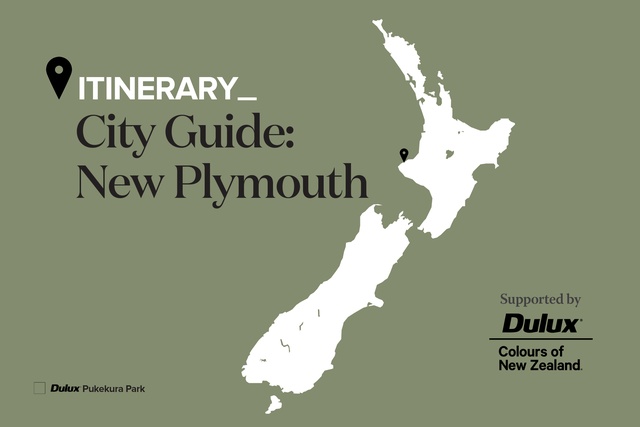
One of New Zealand’s first colonial settlements, New Plymouth’s temperate climate, fertile soils, and genial Englishness led to early settlers calling it “the paradise of New Zealand”. Looking closer, the picture is more complicated; the city presents something of a microcosm of the nation’s colonial story: intermittent Māori occupation, settler arrival, dicey land deals, Māori resistance, violence, with the relentless colonial project eventually prevailing. Indeed, Taranaki history is particularly dramatic, involving some of most uplifting (Parihaka) and most deplorable (Parihaka again) moments in our young nation’s history.
The Plymouth Company was established in 1840 to settle the Taranaki region, and New Plymouth was named after it by Frederic Carrington, the surveyor who laid out the town’s central blocks. Settlers began arriving in 1841, and by 1843 nearly a thousand people had arrived, half of them children. This was the start of a period of rapid expansion nationally, as thousands of settlers poured in - by the late 1850s, Pākehā outnumbered Māori across the then relatively sparsely populated country. New Plymouth’s settlers, however, had arrived at a moment when the Māori that occupied the area had migrated away, and the legitimacy of many of the land transfers was questionable. Dubious land sales at Waitara sparked the Taranaki Wars in the early 1860s. For a time New Plymouth was under siege, colonists retreating behind gated fortifications where overcrowded conditions caused scores to die from disease.
Despite this turmoil, the city remains the location of some of the oldest surviving architect-designed buildings in New Zealand. Arriving in 1843 among New Plymouth’s first settlers was Frederick Thatcher, a London-trained architect. He intended to become a farmer but was drawn into design and civic administration. At the direction of Bishop Selwyn he designed St. Mary’s (Listing 1) and at direction of Governor Sir George Grey designed one of four hospitals (Listing 2) ambitiously intended to serve both Māori and settlers.
Visiting the city now, the impression is of a town intact. The centres of most of our regional towns and cities have been damaged by the combined impact of big box retail, seismic code-induced demolitions, and population drift, resulting in gap-toothed main streets where parking lots and “For Lease” signs outnumber banks and post offices. How did central New Plymouth survive, where other cities have descended into two-dollar shop purgatory? They pull money out of the ground. Powered by dairy farming, oil, and gas, Taranaki has the highest per capita GDP of any region in the country – well clear of second-place Wellington and more than 20% higher than third-place Auckland. New Plymouth’s centre hasn’t been subject to the waves of economic stagnation that allow the two-dollar shops to slip in. Instead, private wealth and a healthy tax take have supported great domestic and commercial architecture, as well as cultural facilities like the Len Lye Centre and Puke Ariki.
Due to both its early prominence and ongoing wealth, New Plymouth is unlike many other provincial New Zealand cities in that its townscape isn’t dominated by the work of architects from the main centres; it was made largely by architects who lived there. Thatcher, Messenger, Bates, Laurenson, and the Boon team have been able to create significant bodies of work, including the more glamorous commissions that in Rotorua or Palmerston North would be scooped up by a well-connected Wellingtonian or a well-dressed Jafa.
However, Taranaki has recently slid into negative GDP growth. Shane Jones has been sprinkling his regional fairy dust, but a rising antipathy to fossil fuels may start to let the air out of New Plymouth’s balloon. If that does happen, it will be a slow leak rather than a big bang. The city will long remain one of the best places to see the full range of our architectural (and social) history.
THE ITINERARY
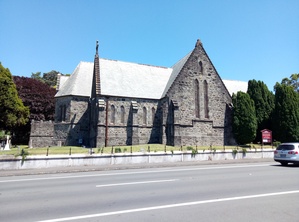
01. 1846 – Cathedral Church of St. Mary
37 Vivian Street, City
The original stone structure was designed by Frederick Thatcher at the start of his long career in New Zealand. The oldest surviving stone church in the country, it stands as an example of the Gothic Revival design promoted by Augustus Selwyn, NZ’s first Anglican Bishop, but is special in being successfully built in stone rather than the timber that soon became typical. Thatcher’s nave has been considerably expanded over the years by various architects including Benjamin Mountfort (known for St Mary’s Cathedral, Auckland), Tole & Massey (Cintra Flats, Auckland) and William Alington (Upper Hutt Civic Centre). The building is currently closed pending seismic strengthening. Thatcher also designed the stone Te Henui Parsonage (1845) at 290 Courtney Street, Strandon.
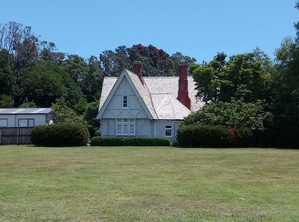
02. 1847-8 – The Gables
Brooklands Park Drive, City
Thatcher is best known as the architect of the charming Chapel of St. John the Evangelist in Meadowbank, Auckland (1847) and Old St Paul’s in Wellington (1866). The Gables set the pattern for these later buildings - the timber sheathing is placed inside the timber frame, expressing the structure externally to great decorative effect. Now a Category 1 Historic Place, the building was one of four colonial hospitals commissioned by Governor Sir George Grey. Little used, it was eventually purchased by Newton King and moved from its former site on what is now New Plymouth Girls’ High School to Brooklands to serve as a residence. Later gifted to the city, it became an arts centre in 1985. Refer Historic Places in NZ March 1986.
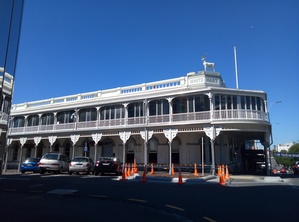
03. 1886 – White Hart Hotel
Cnr Devon & Queen Street, City
Registered as a Category 1 Historic Place, the original sections of this local landmark were designed by James Sanderson. The distinctive balconies were added in in 1909 by Frank Messenger, who had a tremendously long career and was responsible for a huge number of buildings in and around New Plymouth (see listing 5). The building’s condition deteriorated through a long and somewhat wild history, but it has now been renovated by Wellington firm Bonnifait + Giesen, preserving the façade, sprucing up the interior, and creating a new covered courtyard. Refer Architecture NZ Sept/Oct 2012. Check out the PoMo stylings of Boon Goldsmith’s 1985 Clock Tower across the road, which re-housed a clock from a demolished 1907 Post Office.
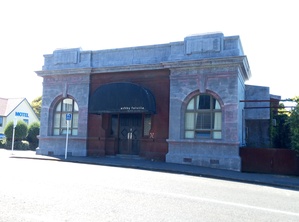
04. 1920/1925 – Former Public Trust Office
Cnr King & Queen Streets, City
Thomas Bates stands alongside Frank Messenger as a key creator of New Plymouth’s cityscape. Whereas the 300-odd surviving Messenger buildings are mostly wooden houses, Bates’ legacy includes many commercial buildings still standing in the city centre. He was also responsible for the neoclassical State Fire Insurance (1924) at 42 Egmont Street, the former Opera House (1925) at 92-100 Egmont Street, the four-storey Colliers Building (1926) at 18 Devon Street, the Art Deco YWCA (1929/1934) at 74 Powderham Street, and the Taranaki Daily News (1937) on the corner of Powderham and Currie Streets. Art Deco fans note the National Bank Building (1939) by Mitchell & Mitchell at the corner of Brougham and Devon Streets.
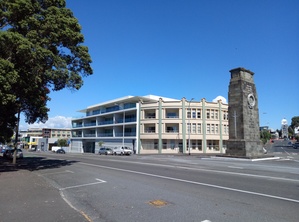
05. 1927 – St Aubyn Chambers
Cnr St Aubyn & Queen Sts, City
Marking New Plymouth’s transition from a town to a fully-fledged city, this building originally combined functions in a way that would even now be radical – a car service station at street level with central city apartments directly above. It was also technologically advanced, being the first all-reinforced concrete building in the city and one of the earliest in the country. While the original interior has been stripped out, the dramatic curving façade is largely intact. Located on a portion of what was the important Puke Ariki pa site, the building is a Category 2 Historic Place. Messenger’s firm also designed the 1924 Cenotaph across the road, and the 1924 Devonport Flats along at 127- 131 St Aubyn Street.
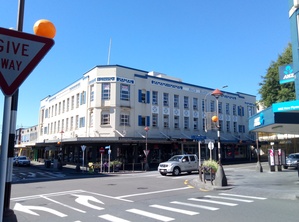
06. 1927 – King’s Building
Cr Brougham & Devon Sts, City
This building is linked to key figures in New Plymouth’s history. It was built for successful local businessman Newton King, owner of the Gables (see Listing 2) and older brother of Plunket founder Truby King. Their father, Thomas King, had arrived on the first ship of settlers in 1841, later serving as an MP in New Zealand’s first two Parliaments. This building has been renovated numerous times, producing results higher and lower on the aesthetic spectrum - the current façade is relatively calm. Gummer & Ford also designed the 1968 NZI Building on the corner of Currie & Ariki Streets, although the buildings’ crisp modernism is now submerged under later renovations.

07. 1932 – Tupare
487 Mangorei Rd, Highlands Pk
Chapman-Taylor, the nation’s premier Arts & Crafts architect, was raised in the Taranaki. Despite a nomadic career ranging from Khandallah to Manurewa, Chapman-Taylor designed a number of buildings in his home region. Tupare was created for Sir Russell Mathews, founder of a firm that became NZ’s largest roading contractor. Matthews was an opinionated client, and the house varies considerably from JWCT’s original design. The garden is publicly accessible, and free tours of the house are available on several days of the week during summer - refer www.tupare.nz for information. Serious JWCT fans might swing by Plas Mawr (1913) at 26 Standish Street, Westown. Listed as a Category 1 Historic Place, this private home is visible to the public only as a shingled roof over a high, ivy-covered fence.
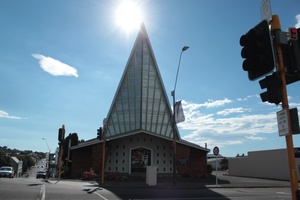
08. 1963 – Whiteley Memorial Church
58 Liardet Street, City
Designed by Bowering with Abbott, Hole & Annabell, this soaring space is one of the best known of the highly geometric designs that characterized New Zealand church design in the 1960s. Bill McKay has described the spatial drama: “Beyond the welcoming porch and though a small, solid vestibule, the space expands and the huge roof over the nave is thrust high as if the cranked steel portals were upraised hands.” The Methodist building received an NZIA Enduring Award in 2007. Refer NZIA Journal Oct, 1964. Pop across the road to the Fire Station (1965), designed by the young John Sutherland (later of JASMaD fame) in the office of local architect Edgar T. Collins. Refer NZIA Journal Oct. 1970.

09. 1965-72 – NPBHS Ryder Hall
107 Eliot Street, City
Designed by White for the Taranaki Education Board, this performance hall and classroom block is encased in a Brutalist shell that marks it out as a radical departure from standard school architecture. A 10m-high in-situ concrete wall wraps smoothly around the street corner, a dramatic fire escape and a modernist sculpture animating the façade. The interior is a theatrical composition of fair-faced concrete, pale timber, and gentle sidelight. Another notable building on the campus is Pridham Hall. Dating from 1919, it was designed by Auckland-based William Cumming, architect of St Kevin’s Arcade and the second Director of Auckland University’s architecture school.
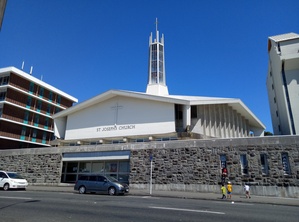
10. 1969 – St. Josephs Church
106 Powderham Street, City
Like Whiteley, built a few years earlier, externally this church is all about geometry and structure – a folded plane roof over a hexagonal plan, all propped on a pin-jointed frame. On the interior, designed to seat a thousand people, note the immersion baptismal set into the floor, and The Stations of the Cross created by New Plymouth-born artist Michael Smither. A youth hall in the basement is neatly configured to have access from the adjacent street. The church received an NZIA Enduring Award in 2002. Fans of Enduring gems should check out the New Plymouth Telephone Exchange (1982) by Boon Goldsmith at 927 Liardet Street.
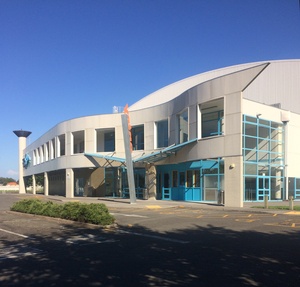
11. 1992 – TSB Stadium
1 Rogan Street, Welbourne
As large, essentially blank boxes related primarily to carparks, stadiums like this are a tough design challenge. This one is elegantly handled, with a thin, late PoMo façade wafting across the frontage to mediate between the car park and the interior. Fans of BGBB could consider a visit to Todd Energy Aquatic Centre (2008) at 8 Tisch Ave (low key from the street, but a great interior), or a drive-by of BGBB’s TSB Cancer Support Centre (2009) at 71 Lorna Street, Lynmouth. The later project received numerous awards in 2009: an NZIA Regional Award, an NZIA Resene Colour Award, and an NZ Wood Timber Design Award.
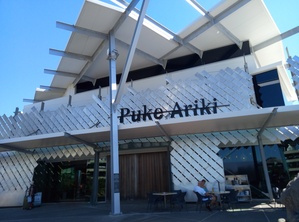
12. 2003 – Puke Ariki
1 Ariki Street, City
This fantastic regional museum and library is the ideal place to start a tour of New Plymouth – check out out the natural history and historical displays. Architecturally, the building is a magnificent blend with Māori and Pacific references rendered in industrial steel, and incorporating a number of existing buildings: fragments of a significant 1922 Messenger, Griffiths & Taylor-designed store; an overbridge that connects to the library in the 1960 War Memorial Building designed by Taylor & Collins; the historic Richmond Cottage (1854) tucked in alongside. Refer Architecture NZ Mar/Apr 2003. Pop around the back to the NPDC Bus Depot, designed by BGBB in 2004, and winner of an NZIA Local Award in 2005.
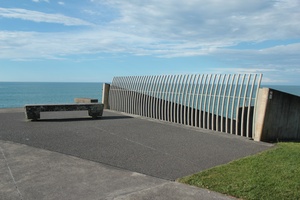
13. 2006 – Liardet Street Overpass
Cnr Liardet & St Aubyn Sts
New Plymouth city centre is in great shape but like Tauranga, another otherwise appealing regional city, it is rather unfortunately cut off from the waterfront by a train line. This overpass links – almost effortlessly – the northern end of the city to the Coastal Walkway. The project received numerous awards, including NZIA Regional and National Architecture Awards in 2009/2010, and was a Highly Commended at the grandly named Ingenium Excellence Award in 2007. Refer Architecture NZ Jan/Feb 2010 and May/June 2010. BGBB also completed the apartments nearby at 22 Liardet Street, winner of an NZIA Local Award in 2008.
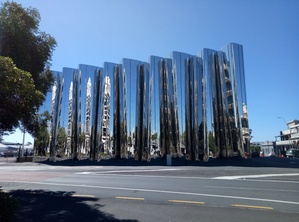
14. 2015 – Len Lye Centre
42 Queen St, City
Described by Jeremy Hansen as the perfect building for the Instagram age, the LLC now stands alongside Wellington’s Beehive and Auckland’s Skytower as one of NZ’s most recognizable buildings. The stainless steel façade, laid over pre-cast concrete panels that are expressed internally, evokes Lye’s sculptural work and turns the building into an arresting urban presence. Ramps link the galleries with the fragmented floor levels of the Govett-Brewster – a former picture theatre adapted as an art gallery in 1970. See Architecture NZ Sept./Oct. 2015 and Home NZ Aug./Sept. 2015.
Other Addresses
AMP Insurance Society Building (1916) – Cnr Devon and Egmont Streets, City Frederick de Jersey Clere.
St Andrew’s Church (1932) – Cnr Courtney & LIardet Sts Frederick de Jersey Clere.
New Plymouth Courthouse (1967) – 94 Powderham Street, City Ministry of Works A crisp Brutalist gem. The portico was added and internal alterations made in the late 1990s.
T & G Building (1972) – Cnr Liardet & Devon St East Stevenson & Turner.
Egmont Street Shopping Development (1984) – Cnr Egmont Street & Devon St West Fletcher Construction.
City Centre (1988) – 11 Gills Street, City Roger Walker This mall opened in 1988, but has since been renovated with a colourful but fairly generic contemporary design that removed almost all traces of Walker’s hand.
TSB Showplace (1999) – 92-100 Devon Street West BGBB Team Architects.
New Plymouth Girls High School Millennium Block (2000) – 60 Northgate Road, Strandon Dickson Lonergan Architects.
Huatoki Plaza (2010) – 18 Devon Street West BGBB Team Architects With a delicacy and dynamism unusual in New Zealand, a light roof is propped at a jaunty angle.
Plunket Hub (2014) – 214 Devon Street West Elliot Architects.
The town is host to fantastic public art, principally along the 13km-long Coastal Walkway, most notably Len Lye’s Wind Wand. Also check out Filipe Tohi’s Halamoana (2003) Cnr Brougham and Powderham Sts, commissioned by architect Terry Boon, and John Reynold’s Big Wave Territory (2011) at the Port.
SOURCES
The photos are by Jade Shum and Andrew Barrie. Visit Puke Ariki and buy ($10) a copy of New Plymouth Historical Walks (New Plymouth: Puke Ariki, 2010). It covers in detail many of the buildings included in this guide. Judy Seirs’ book The Life and Times of James Walter Chapman-Taylor (Napier: Millwood, 2007) covers Tupare and tells of JWCT’s youth in pioneer-era Taranaki. Margaret Alington has written two useful books - Goodly Stones and Timbers: A History of St Mary’s Church, New Plymouth (New Plymouth: The Church, 1988) and An Excellent Recruit: Frederick Thatcher (Auckland: Polygraphia, 2007). Ian Pritchard’s self-published book, Frank Messenger, Architect: The Work of a New Plymouth Architect (New Plymouth: Ian Pritchard, 1994) covers many of his important buildings. Ryder Hall and the Whiteley Memorial Church are covered in Julia Gatley’s Long Live the Modern (Auckland: Auckland University Press, 2008). Whiteley is also covered in Bill McKay’s Worship: A History of New Zealand Church Design (New Zealand: Godwit, 2015). For more general New Plymouth history, see J. S. Tullett’s The Industrious Heart: A History of New Plymouth (New Plymouth: NPDC, 1981).

The itinerary series is supported by Dulux Colours of New Zealand. Dulux Colour Specialist Davina Harper has selected a Colours of New Zealand palette based on this itinerary. See the full range and order colour samples here.









